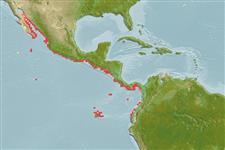Environment: milieu / climate zone / depth range / distribution range
Ecología
marino asociado a arrecife; rango de profundidad 5 - 23 m (Ref. 5227). Tropical; 30°N - 1°S, 120°W - 70°W
Eastern Central Pacific: Gulf of California to northern Colombia and the Galapagos Islands.
Tamaño / Peso / Age
Maturity: Lm ? range ? - ? cm
Max length : 60.0 cm TL macho / no sexado; (Ref. 40637); peso máximo publicado: 4.2 kg (Ref. 40637)
Short description
Claves de identificación | Morfología | Morfometría
Body moderately deep and compressed; dorsal fin with 10 thick spines and 11 to 12 soft rays (X,11-12); interspinal membranes with terminal cirri; pectoral fins wide, with 14 rays, the lower 7 thickened and unbranched, with notched membranes; body olive green to red, with 4 dark oblique bars with cobalt blue borders; head with similar dark bars (Ref. 55763).
Solitary, bottom-living in shallow waters (Ref. 28023). Lies very still on rock ledges and is well camouflaged against the rocks. Feeds on crustaceans and small fishes (Ref. 37955). Considered a good food fish (Ref. 9289).
Life cycle and mating behavior
Madurez | Reproducción | Puesta | Huevos | Fecundidad | Larva
Bussing, W.A. and R.J. Lavenberg, 1995. Cirrhitidae. Chinos, halcones. p. 1007-1010. In W. Fischer, F. Krupp, W. Schneider, C. Sommer, K.E. Carpenter and V. Niem (eds.) Guia FAO para Identification de Especies para lo Fines de la Pesca. Pacifico Centro-Oriental. 3 Vols. FAO, Rome. (Ref. 9289)
IUCN Red List Status (Ref. 130435: Version 2024-1)
Threat to humans
Harmless
Human uses
Pesquerías: comercial; pesca deportiva: si
Herramientas
Special reports
Download XML
Fuentes de Internet
Estimates based on models
Preferred temperature (Ref.
123201): 21.6 - 29.1, mean 26.7 °C (based on 117 cells).
Phylogenetic diversity index (Ref.
82804): PD
50 = 0.5625 [Uniqueness, from 0.5 = low to 2.0 = high].
Bayesian length-weight: a=0.00933 (0.00385 - 0.02260), b=3.08 (2.87 - 3.29), in cm total length, based on LWR estimates for this (Sub)family-body shape (Ref.
93245).
Nivel trófico (Ref.
69278): 4.0 ±0.67 se; based on food items.
Fishing Vulnerability (Ref.
59153): Moderate vulnerability (44 of 100).
Nutrients (Ref.
124155): Calcium = 42.5 [27.0, 64.0] mg/100g; Iron = 0.593 [0.384, 1.010] mg/100g; Protein = 19.5 [18.6, 20.5] %; Omega3 = 0.126 [0.088, 0.179] g/100g; Selenium = 35.9 [21.8, 60.2] μg/100g; VitaminA = 50.6 [20.3, 128.0] μg/100g; Zinc = 1.08 [0.79, 1.44] mg/100g (wet weight);
